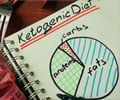A high fat, low carbohydrate diet in patients with severe form of epilepsy seems to halt the condition and reduce the frequency of their seizures.
Highlights
- The high-fat, low-carbohydrate ketogenic diet was a safe and effective treatment option for the majority of adults experiencing severe seizures.
- Super-refractory status //epilepticus (SRSE) is the most severe seizure classification, in which up to an estimated 60 percent of patients die. In patients with SRSE, ketogenic diet reduced the episodes of seizures but more research is needed to confirm its effect.
- Ketogenic diet is effective in approximately one-third of adults with epilepsy who are resistant to traditional anti-seizure drugs according to previous research.
"Because there isn’t a standard treatment for super-refractory status epilepticus and those patients diagnosed have such a high death and disability rate, we decided we had to try something different to treat them and test its safety and value."
Epilepsy
Epilepsy is a disorder in which nerve cell activity in the brain is disturbed, causing seizures. Super-refractory status epilepticus can occur in people who already have a seizure disorder or in those without such a history.
According to the Centers for Disease Control and Prevention, more than 5 million people in the U.S. have a seizure disorder.
In general, after a patient has experienced 24 hours in a seizure and there have been multiple failed attempts to stop it with drugs, physicians will use general anesthetics to put a patient in a coma to protect the muscles, kidneys and brain from damage -- common side effects of prolonged seizure episodes.
For the study, the research team recruited 15 patients hospitalized with super-refractory status epilepticus at The Johns Hopkins Hospital, Mayo Clinic, the Queen’s Medical Center in Honolulu and Thomas Jefferson University Hospital in Philadelphia.
The patients ranged in age from 18 to 82. Five were men, and six had a previous history of some form of epilepsy prior to developing super-refractory seizures. Patients in the research population had taken an average of eight anti-seizure medications before physicians introduced a commercially prepared ketogenic diet.
Ketogenic Diet
The rationale for the high-fat ketogenic diet, is based on the fact that it accelerates the body’s metabolism of fats, similar to fasting, which appears to alter the excitability of nerve cells in the brain. When most of a person’s calories or energy come from fat, the body accumulates metabolic breakdown products known as ketone bodies. Ketones are easily measured in the blood and urine.
The diet contained a nutrient liquid composed of four parts fat to one part carbohydrates and protein combined in grams. Each patient received the diet through a feeding tube over 72 hours, with their calorie needs calculated based on weight, while in a medically induced coma.
After 72 hours on the diet, the physicians tapered off their anesthesia to see if the seizures had stopped. If the seizures did not return at this point, patients continued with the diet for several days until they could eat on their own, at which time they were switched to a modified Atkins diet, which is high in fat and low in carbohydrates as well.
If a patient’s seizures continued, he or she was kept on the feeding tube ketogenic diet, but additional anti-seizure medications were given as well.
After two days, all patients had detectible levels of ketones, showing that they were metabolizing fat -- rather than carbohydrates or proteins -- for cellular energy.
Effects of the Ketogenic Diet
- One patient among the 15 was taken off the diet when family members requested to withdraw care and died. In 11 of the remaining 14, or 79 percent, who completed the full course of the ketogenic diet, super-refractory seizures stopped, with eight recovering within a week after the episode started.
- Ten of the 15 patients experienced adverse effects of the diet, which included constipation, weight loss, low blood sugar, high cholesterol in the blood and low sodium levels in the blood.
- Altogether, six of the 11 patients who completed the ketogenic diet course in the hospital eventually switched to a modified Atkins diet, which is easier to follow than the ketogenic diet.
Two patients who remained seizure-free tapered off the diet because they found it difficult to follow. Two patients reported their seizures reduced by more than 50 percent, two had ongoing seizures, one had experienced a single seizure and none experienced return of status epilepticus.
Need for Further Research
The researchers caution that much further research will be need to support the idea that the ketogenic diet should be widely used in those with this severe form of epilepsy.
"We can only state that it appears to work in some patients to halt status epilepticus and reduces the frequency of their seizures," says Cervenka.
The researchers plan to carry out phase III randomized controlled clinical trials to determine the actual rate of effectiveness by comparing those treated with the ketogenic diet to a group tube-fed a normal, nonketogenic diet.
"What we can say is that the ketogenic diet is promising for at least a subset of patients. Any safe means we have of getting patients off of anesthesia and out of a coma quickly will be welcome," says Cervenka.
Reference
- Mackenzie C. Cervenka et al., Ketogenic diet shown safe and effective option for some with rare and severest form of epilepsy, Neurology (2017).
Source-Medindia















